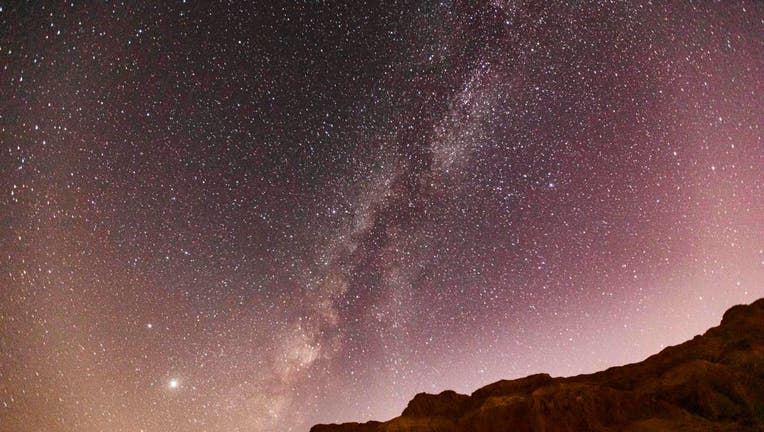Astronomers find 24 ‘superhabitable’ planets within Milky Way galaxy

FILE - This long-exposure picture taken early on August 20, 2020, shows a view of the Milky Way galaxy rising in the sky above the Judaean mountains in the occupied West Bank between Palestinian Jericho and Israel's Ein Gedi.
A recent study published in the journal Astrobiology, found that there are more than a dozen “superhabitable” worlds in our galaxy.
Astronomers have identified 24 possible “Earth-like” worlds within the Milky Way galaxy “even better for life than our Earth,” according to the study authored by geologist, Dirk Schulze-Makuch, and astronomers Rene´ Heller, and Edward Guinan.
While there are more than 4,000 exoplanets in the Milky Way, astronomers say that the list of top contenders could host several factors that can support life.
One caveat scientists note is that, while some planets could have all the right ingredients to support life, it does not mean life exists on one of these “superhabitable” planets.
“It is important to note that a planet might be habitable, but lifeless because the origin of life never occurred. This might be because the environmental constraints for the origin of life are much more stringent than for the persistence of life,” the study stated.
RELATED: Fireball seen across several East Coast states was a meteor, experts say
Also, it was noted that during this study, the initiative was not to look for a perfect mirror image of our Earth, but to look beyond an exact twin to our home planet in hopes to find a similar but sustainable one.The study noted that Earth’s history was taken into consideration as well.
“In fact, the natural history of Earth shows that habitability fluctuated quite significantly over geological eons. This does not only refer to major asteroid impacts or other calamities that wiped out large parts of the biosphere, but also long-lasting Snowball Earth Events, which resulted in subdued biospheres for millions of years (Ward and Brownlee, 2000),” according to the study.
Out of the 24 planets believed to be “superhabitable,” one, in particular, stands out the most and fits all the criteria scientists use to determine what makes a planet capable of supporting life.
“Only one of the candidates (KOI 5715.01) fits all three criteria, but it has a predicted lower global temperature than Earth when a gray atmosphere model is used that includes an approximation for a greenhouse effect,” the study stated.
However, none of the 24 planets, including KOI 5715.01, are less than 100 light-years away, the study stated.
“Although none of these planets and planet candidates is closer than 100 light-years and, therefore, inaccessible for high-quality observations from NASA’s TESS mission, we argue that superhabitable planets might well be present in the exoplanet sample known today,” according to the study.
RELATED: Mars to appear extra bright in October during close approach to Earth
Astronomers took into account several factors that help determine what makes a planet “superhabitable,” which include, the lifespan of the star around which the planet orbits. The study references that life on Earth only came into existence 3.5 billion years after it was even formed and about another 4 billion years to technologically advanced life to appear on the planet. Thus, the age of the star will be very dependent on if any of its orbiting planets even had a chance to create life in the first place.
Another factor is the makeup of the planet, for example, does it contain a core, mantle and crust such as Earth? In this particular study, scientists posit that an even larger planet, as well as a more warm and humid planet would actually make for the perfect Earth substitute.
Also, the perfect-sized moon could make or break a planet’s ability to support life. Astronomers stated in this study that Earth was given all of the right ingredients to create a habitable planet, and the moon’s size is actually a big part of that. The size and distance of Earth’s moon creates perfect balance for the tides. If the moon were any closer or larger, “ Earth’s habitability would likely have been worse than it has been due to the tidal locking imposed by the gravitational pull imposed by such a hypothetical moon. Once in tidal locking, the Earth’s day length could be several times its contemporary value, which would have dramatic effects on the surface distribution of sunlight as an external source of energy.”
Despite these observations, scientists say the ultimate determinant of finding another habitable planet would be to be able to look into the history of the planet’s development, which is virtually impossible, the study stated.
RELATED: Rare blue moon to light up night sky on Halloween 2020
“Our point here is not to identify potential targets for follow-up observations but to illustrate that superhabitable worlds may already be among the planets that have been detected,” the study continued.
However, this does not mean finding another, possibly better “superhabitable” planet is impossible.
“Should such a planet be discovered within about 100 light-years in the near future, then such a world would deserve higher priority for follow-up observations in search of extrasolar life than the most Earth-like planets,” the study concluded.


